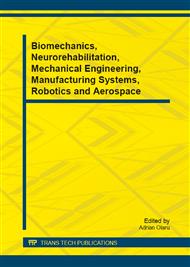p.297
p.303
p.310
p.316
p.323
p.330
p.334
p.340
p.346
The Faster Detection of the Step Initiation and the Prediction of the First Step’s Heel Strike Time with the Vertical GRF
Abstract:
A new approach for the detection of the step initiation in the lower extremity exoskeleton is presented. As the detection of the step initiation is the important factor for the lower extremity exoskeleton to shadow the operator’s movement as soon as possible, many studies have been done to detect it faster by using heel-off time or toe-off time. We detect the step initiation faster than other approaches with the vertical ground reaction forces. Also, we predict the first step’s heel strike time with the regression equations based on the vertical ground reaction forces as soon as we detect the step initiation. It could enable the lower extremity exoskeleton to shadow the operator’s movement much faster.
Info:
Periodical:
Pages:
330-333
Citation:
Online since:
December 2012
Authors:
Keywords:
Price:
Сopyright:
© 2013 Trans Tech Publications Ltd. All Rights Reserved
Share:
Citation:


